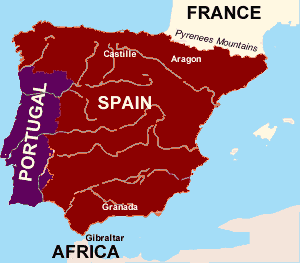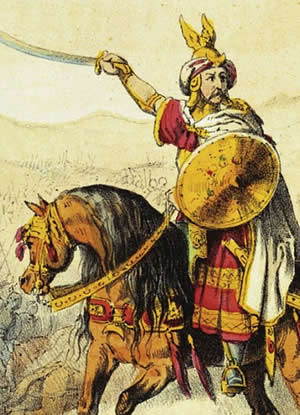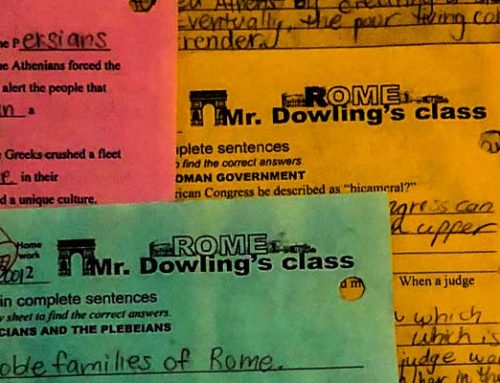Muslim warriors crossed the narrow Strait of Gibraltar in the eighth century to invade the Iberian Peninsula in the southwest corner of Europe. Muslims controlled parts of present-day Spain and Portugal for the next 800 years.
In 409, the Roman government in Spain fell to Germanic-speaking warriors called Visigoths, or Western Goths. The Visigoths migrated into the Roman Empire from the east to escape the Huns. During the three centuries that followed, Christianity spread through the peninsula, and the Visigoth’s Germanic culture blended with the native population of the peninsula.

Rock_of_Gibraltar
The Rock of Gibraltar is a limestone rock located off the southwestern tip of Europe on the Iberian Peninsula.
Arab and Berber Muslims crossed the nine-mile-wide waterway between Africa and Europe in 711 to land on a mountain of stone that juts out from Spain. The Spanish called the invaders Moors, meaning “dark-skinned.”
The leader of the 10,000 invaders was Jabal Tariq, and the point where the Muslim army landed became Mount Tariq. We now call the narrow channel separating Europe from Africa the Strait of Gibraltar, a word derived from the local pronunciation of Jabal Tariq. Mount Traiq is now the Rock of Gibraltar.
Tariq’s army met with little opposition from the Visigoths, so they managed to control most of the peninsula by 719. The Moors could only control some of the Iberian Peninsula because several small Christian kingdoms remained in the north. Tariq’s army crossed the Pyrenees Mountains and attempted to invade the land we now call France in 732, but the Muslim army was defeated at the Battle of Tours by Charles Martel, the grandfather of Charlemagne.

Iberian_peninsula
Spain and Portugal comprise the Iberian Peninsula in southwest Europe.
Spain was known by its Arabic name, Al-Andalus for the next three hundred years. The Moors were tolerant of the Christians and Jews who lived in the land they conquered, but they taxed the people who did not share their Islamic faith at a higher rate. Consequently, some citizens converted to Islam to avoid paying higher taxes.
The Moors formed a caliphate, or religious center, in Cordoba. Scholars studied the works of Greek and Roman authors, while artists and architects established the city as a center of the arts. Cordoba also became a center for studying mathematics, astronomy, and agriculture.
A civil war among the Muslims in the eleventh century caused the caliphate’s collapse into small kingdoms called taifas. The disunity allowed for the Christian reconquest of Spain.
Christian warriors began the Reconquista, or reconquest of the peninsula 1085. The Christian kingdoms of Castille and Aragon in northern Spain won several military victories. After years of fighting, a nobleman named Afonso expelled the Muslim rulers from the western part of the peninsula and established the Kingdom of Portugal in 1139. By the end of the thirteenth century, only the Emirate of Granada in southwest Spain remained under Muslim control.

Jabal_Tariq
Jabal Tariq (Tariq ibn Ziyad) (c.670 – 720) was a Muslim general who led the Islamic conquest of Spain in 711. The Rock of Gibraltar off the southern tip of Spain is named for him. Gibraltar is a corruption of “mountain of Tariq.”
In 1469, the two most influential Christian kingdoms on the peninsula united through the marriage of Ferdinand II of Aragon and Catherine of Castile. The “Catholic kings” built roads, and standardized laws and coinage throughout their kingdoms. In 1492, Ferdinand and Isabella’s armies captured Granada, Spain’s last Muslim territory. Soon after, the monarchs ordered all Muslims and Jews to convert to Christianity or leave their kingdom.
As the Muslims retreated to Africa, Spain began to look west. The same year Ferdinand and Isabella banished Jews and Muslims from Spain, Isabella financed the sailing expedition of Christopher Columbus, which led to the establishment of a Spanish Empire in America.
Resources
Download this lesson as Microsoft Word file or as an Adobe Acrobat file.
Listen as Mr. Dowling reads this lesson.

703charles_martel
Charles Martel (c. 688 –741) was a Frankish military leader who fought the Moors. This statue of Charles Martel is at the Palace of Versailles




